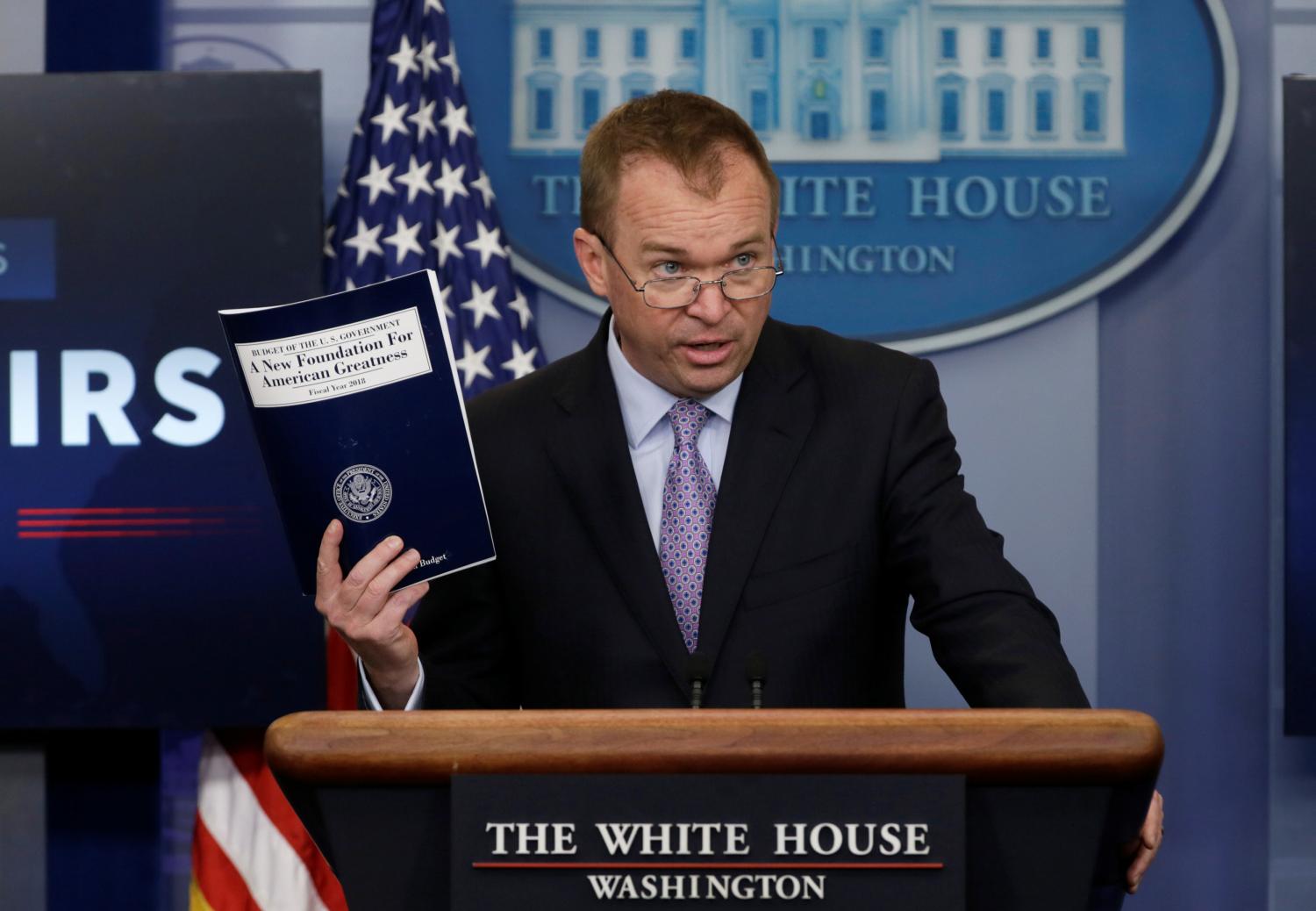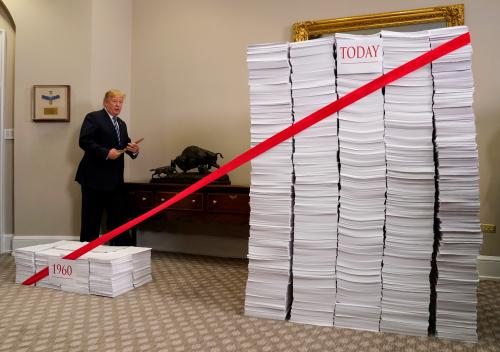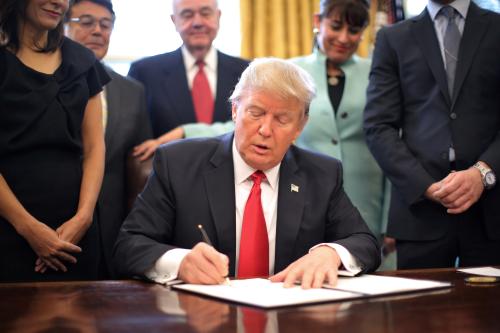This report is part of the Series on Regulatory Process and Perspective and was produced by the Brookings Center on Regulation and Markets.
The Trump administration’s executive order requiring agencies to eliminate two rules for every new rule (“one in, two out”) has received a great deal of attention but little analysis of how it has worked in practice. Has the order chilled regulation that imposes new costs altogether? Or have agencies added new rules that impose costs while diligently eliminating old ones? Or have agencies managed to skirt the order and issue rules that impose new costs without providing deregulatory offsets? In short, how has the order actually affected rulemaking?
These questions can be more fully addressed now that the order has been in effect for approximately 18 months. This piece analyzes two key questions. First, have agencies under Trump issued new rules with costs? If so, what motivated these rulemaking efforts and how did they justify such rules? Second, did agencies issue deregulatory rules to offset new rules that impose costs? If so, were these deregulatory rules meaningful or relatively minor?
In brief, this piece finds that Trump administration agencies issued very few new rules that imposed regulatory costs. Most such rules were required by statute or were otherwise routine. On the flipside, Trump agencies also did relatively little deregulation outside of delaying and repealing rules issued late in the Obama administration. On balance, then, the picture is one of inaction. The Trump administration has halted the growth of regulation that imposes costs but so far has left the existing regulatory framework largely in place.
Background
Executive order 13771 and implementing guidance from the White House Office of Management and Budget (OMB) and its Office of Information and Regulatory Affairs (OIRA) applies to agencies that have long submitted their rules to OMB for review (independent regulatory agencies such as the Federal Communications Commission are exempt from such review). Under the order, agencies must remove two existing rules for each new important rule or guidance document they issue. In guidance, OMB has created a number of important exceptions to this “one in, two out” rule. Most importantly, it does not apply to rules or guidance documents that are: 1) deemed to be “nonsignificant” (e.g., less important on policy grounds) by OMB; 2) required by statute; 3) impose little or no costs; 4) relate to national security; or 5) transfer payments to beneficiaries of programs (e.g., Medicare payment rules). This piece analyzes the extent to which OMB has granted these exemptions to agencies.
Has the Trump Administration Imposed New Regulatory Costs?
Total rulemaking is clearly down across the board under the Trump administration. While this result is important, it begs an additional question: to what extent have rules issued under Trump imposed regulatory costs? This piece draws on data from the Government Accountability Office’s (GAO) Federal Rules Database and from OMB’s Reginfo database to analyze this question (these databases have somewhat different information and different advantages for research).
The short answer is that Trump era agencies have not issued many rules that impose costs. From the start of the Trump administration to July 15, 2018, agencies subject to the executive order issued only 39 “major rules.” Such rules are generally those deemed as having a $100 million annual impact on the economy, a widely accepted if somewhat rough measure of the subset of important rules (a broader measure of important rules used by OIRA yielded similar results)1.
The vast majority of the 39 major rules issued under Trump did not impose significant regulatory costs.
The vast majority of the 39 major rules issued under Trump did not impose significant regulatory costs. Instead, these rules were mostly mandatory and routine. The rules, which are listed in the appendix, fall into the following categories:
- Deregulatory rules initiated by the Trump administration (8)
- Withdrawals and delays of Obama-era rules (6)
- Removal of rules disapproved by Congress and the President pursuant to the Congressional Review Act (3)
- Periodic update rules (18). Examples include fishing quotas, medical reimbursement rates, hunting season rules, annual EPA standards (fuel, water, and air quality), patent fees, and passport fees.
- Rules implementing changes dictated by statutes (2)
- New regulations (2)
Only the final category, new regulations, imposes the type of regulatory costs targeted by the order. The other rules are either deregulatory, routine and required updates, or legally required changes that entail little agency discretion.
Only one of the 39 major rules truly falls into the category of imposing new regulation2. The Department of Energy’s rule on standards for walk-in freezers and coolers did impose new regulatory costs but it reflected consensus negotiations among relevant stakeholders, reducing opposition. Perhaps for this reason, the rule received only 19 comments, most of which were favorable3. The Department recognized the rule’s compliance costs but also monetized significant benefits from energy savings. This rule therefore suggests that a high level of consensus and perhaps quantified benefits are sufficient in limited cases to impose new regulatory costs. In any case, the overall picture is clear: the Trump administration stayed true to its rhetoric and did not issue costly new rules.
Has the Trump Administration Issued Deregulatory Rules?
While the above discussion shows that Trump administration imposed few new regulatory costs, this section suggests that it has also done relatively little deregulation. The most comprehensive accounting of Trump-era deregulation comes from OIRA. In December 2017, OIRA compiled a list of all 66 total deregulatory offsets for Fiscal Year 2017. The deregulatory efforts, which are listed in the appendix, fall into the following categories:
- New deregulatory rules finalized by the Trump administration (24). This category includes allowing importation of additional food products (5), Endangered Species Act determinations (4), and changes in immigration visa caps (2). Notably, 16 of these rules were proposed under the Obama administration.
- Withdrawals and delays of Obama-era rules (including withdrawal of rules proposed but not finalized) (24).
- Removal of rules disapproved by Congress and the President pursuant to the Congressional Review Act (6).
- Periodic updates such as altering health payment rates (2)
- Rules implementing changes dictated by statutes (4).
- Rules largely completed in Obama administration (2).
- Miscellaneous changes such as information collection modifications (1), rules to comply with a court order (1), and rules altering veteran’s benefits (1), and proposed rules (1).
Only one rule on OIRA’s deregulatory list – a delay of Obama-era rules imposing fiduciary standards on certain retirement plan advisors – was classified as “major.” Some of the deregulatory rules, which are detailed in the appendix, concerned fairly narrow subjects such as tax withholdings on a subset of wagering or new electrical safety requirements for certain fuel cell and hybrid vehicles. Many of the other deregulatory rules involved routine issues such as allowing importation of food products, expanding fishing quotas, authorizing additional immigration visas, and issuing Endangered Species Act determinations. While important, such rules are relatively straightforward and do not require the level of policy analysis needed to meaningfully change substantive rules.
Rules in many of the other categories listed above would not require much time or effort from agencies. They also accomplish little in the way of deregulation. Strikingly, one-third (22) of the total (66) deregulatory efforts were proposed during the Obama administration (this does not include rules that were adopted under Obama and repealed by Trump). While in some cases the Trump administration may have made some modifications to these proposed Obama-era policies, it did not do the foundational work of developing a public proposal on which the final version was based. Future deregulatory efforts will likely need to be formulated and proposed by Trump-led agencies, a more resource-intensive process.
Six of the deregulatory efforts (6) were very brief and simple rules effectuating legislative action under the Congressional Review Act to disapprove Obama administration rules. While these rules are technically deregulatory, they do not require significant agency effort and do not further deregulate beyond what Congress already did. The same is true for deregulatory rules that merely implement clear statutory changes. The picture is similar for other categories. Withdrawals of rules proposed by Obama require very little work as they were never finalized and therefore not law. Delays of Obama-era rules, which were typically done either without public notice and comment or with brief comment, also require little work and provide only temporary deregulation.
Some variation exists between agencies. The agencies credited with the most deregulatory rules – EPA, HHS, Interior, and Labor – were also among those associated with imposing costly rules under Obama. Such agencies may have simply had more opportunities to deregulate given that they issued more rules under Obama. Trump administration leaders in such agencies may also have devoted more effort to implementing the deregulatory executive order. Further investigation of particular deregulatory efforts would be necessary to distinguish between these explanations.
It is important to note that the OIRA list of deregulatory actions described above covers only the first nine months of the Trump administration. The data presented in the appendix go forward 9.5 additional months with respect to major rules. The overall composition of deregulatory actions (as measured by the categories above) appears to have remained relatively similar during these two time periods. The pace of deregulation appears to have increased modestly during this time period, suggesting that the administration may be increasing its pace over time. Efforts through mid-July 2018 with respect to major rules remain small relative to the total amount of federal regulation, however. It is important to reiterate that while major rules do cover the most important subset of rules, they are not the entire picture. Agencies undoubtedly completed non-major deregulatory rules and the next OIRA report will likely tabulate such efforts, providing a more complete picture.
Conclusions
To date, Trump administration agencies have issued few new rules that imposed regulatory costs and at the same time did relatively little deregulation outside of delaying and repealing late Obama-era rules. Put differently, the growth of regulation has been largely halted but the existing regulatory framework has largely remained in place. These results may be at least partly the product of “start-up” costs. Any new administration requires time to establish a team and set its priorities and there are some tentative signs that this process has started to yield some results. Once these steps are accomplished, it takes time to draft new rules, seek public comment, and finalize rules. Future work, including a frequently updated deregulatory tracker from Brookings, will shed light on whether the current picture of inaction changes as time passes.
As time passes, the administration may also need to issue rules that impose costs to further its policy agenda. Assuming they are issued, it will be interesting and important to analyze how OIRA applies the offset and regulatory budgeting provisions of the executive order to such rules. These questions will have an important impact on future debates over reform of the rulemaking process and the administrative state more broadly.
The SEC disclaims responsibility for any private publication or statement of any SEC employee or Commissioner. The Article expresses the author’s views and does not necessarily reflect those of the Commission or other members of the staff.
The author did not receive any financial support from any firm or person for this article or from any firm or person with a financial or political interest in this article. He is currently not an officer, director, or board member of any organization with an interest in this article.
-
Footnotes
- OMB evaluates all rules that it deems “significant.” This category is somewhat broader than “major rules.” Only 30 such “significant” rules came through OIRA during Fiscal Year 2017 (by contrast the GAO data extend to July 15, 2018, an additional 9.5 months) and these rules were predominantly mandatory and routine.
- A Department of Homeland security rule requiring additional advance screening for commercial aircraft entering the United States also imposed quantifiable costs but was exempt as relating to national security.
- https://www.regulations.gov/document?D=EERE-2015-BT-STD-0016-0075






